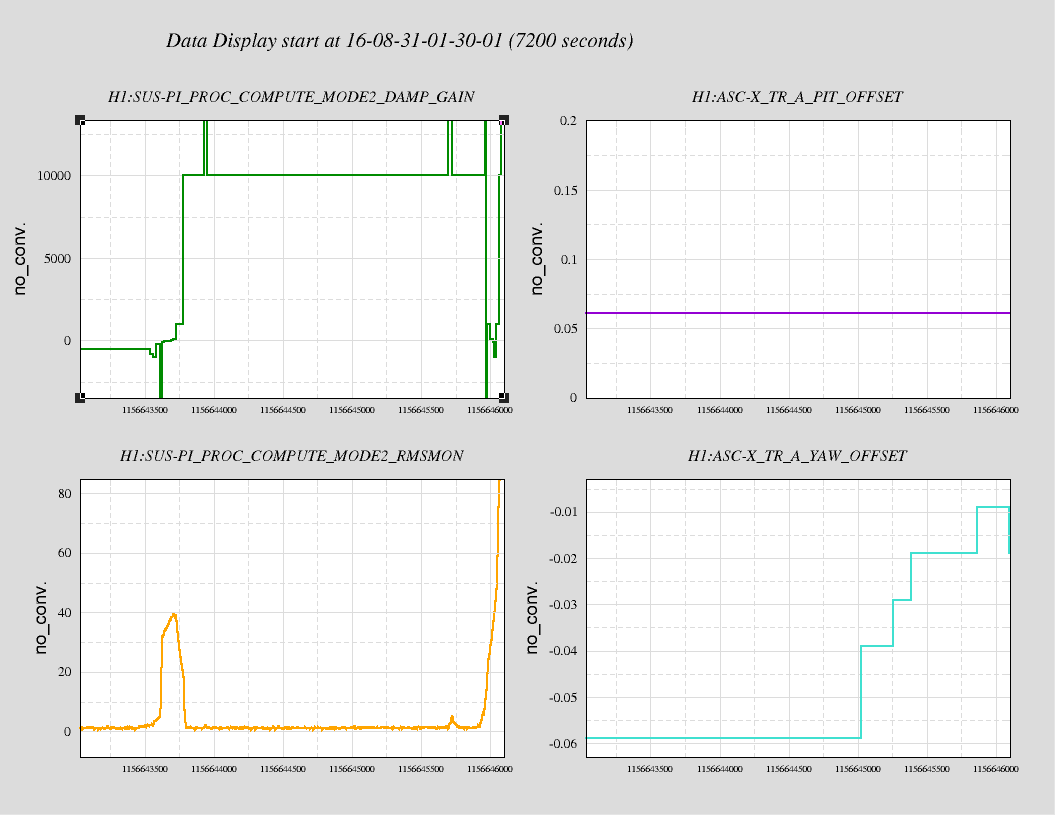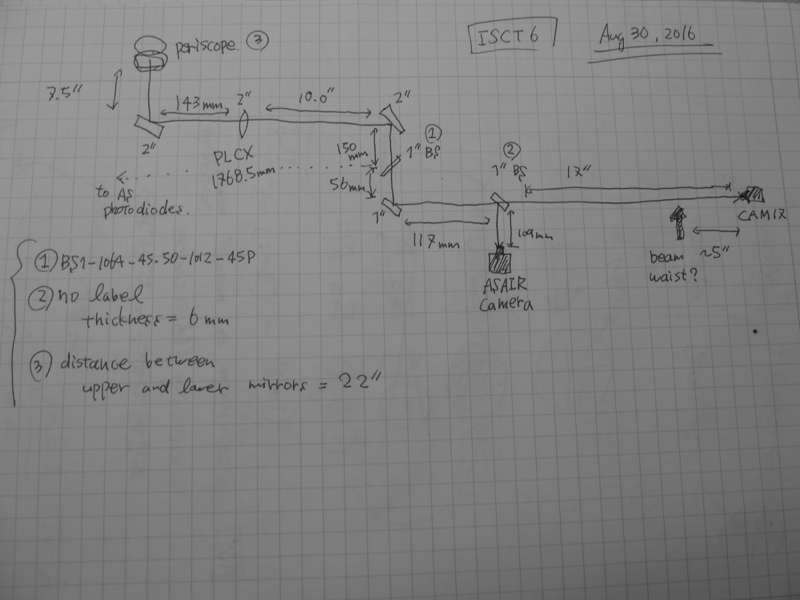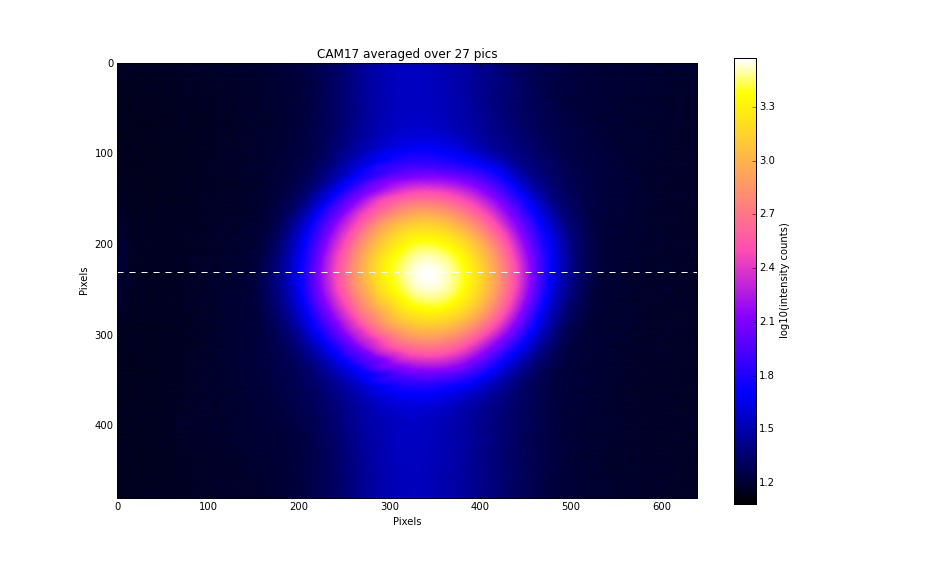Unsuccessful at damping ITMX 15520 Hz PI several times tonight (previously seen here and here). We find that larger damping drive does not equal greater damping: When this mode was test driven and damped after the thermal transient at 50 W, a best gain and phase was found for damping. When the mode began to ring up later, increasing gain (by some large amound but still under saturation) or flipping sign and/or changing phase only resulted in faster ringup. This is true when still far below DAC saturation levels. It seems as if there is some gain sweet spot that must be found.
--- --- ---
We had three occasions to damp ITMX 15520 Hz mode during the night. During the first, I successfully damped and it then rerang up (perhaps due to offset adjustments?) and lost lock. During the second and third I was not able to damp the mode and avoided lockloss only by decreasing power 50 W --> 25 W.
Below you see the mode first ring up and my gain trial and error response until I settle at 10000 and the mode is fully damped. Soon after, you see the mode ring up again right after the yaw offset step from ~ -0.02 --> -0.01. Note we started with a small negative gain so I just assumed we had actually been ringing up the mode the past few days.

During the second 50 W lock, damping was already running at the gain and phase settings that were effective at damping the first ring up above (+10000 gain, -60deg). Despite this, you see the mode slowly rising ~3 hours into the 50 W lock and my gain adjustments trying to damp. Note that here I start with some mostly successful positive gain (i.e. shallow slope) yet both raising the gain and flipping the gain sign cause the mode to ring up. I tried phase changes at this point too but existing was best. I avoided lockloss by decreasing power to 25 W, allowing mode to ring down enough to damp, then powering back up. I also rechecked my gain and phase at 50 W (post thermal transient time) and it would still drive and damp with a very steep slope. Still, an hourish later the mode began to ring up. I found similar behavior in the third attempt as the second and had to decrease power to avoid lockloss.

Things to note:
- After full lock aquisition, this mode takes ~ 3 hours to ring up. This morning, after dropping to 25 W then coming back to 50 W, it took only ~ 1.5 hours to ring up. Suggests something thermal.
- Q_m of ITMX ~= 18M
- Gap between ESD and ITM is larger than for ETMs ==> less actuation per drive
- Kiwamu has found similar higher gain =/= better damping in violin mode damping
Things to try:
- Retry damping immediately after decreasing power; should be able to see within ~1 min of lower power.
- Try driving only one quadrant; test spatial overlap of ESD and mechanical mode
- Turn up ring heater (most likely ETMX RH) to decrease frequency overlap between ITMX mech mode and optical mode
- Check offset dependence
I've plotted the HOM spacing (H1:TCS-SIM_IFO_XARM_HOM_SPACING_HZ_OUTPUT) from the TCS simulator vs the RMS of the 15520Hz PI mode. It seems to be ringing up consistently when the simulated HOM spacing edges up over 5034Hz.

The first plot shows the HOM spacing at the same time that Terra sees and tries to damp the mode. You can see the HOM spacing edge up over three hours as the surface curvature is becoming flatter. The 15520 mode starts to ring up and then Terra is able to damp it. It looks like the subsequent yaw offset increased the power in the arm very slightly which has, in turn, increased the heating of the optic. The estimated HOM spacing increases, most likely increasing the parametric gain of the 15520Hz mode in the process.

The second plot shows the HOM spacing over a larger time frame (19 hours) and the associated RMS of the 15520Hz mode. Every time the HOM spacing reaches 5034Hz, the mode starts to ring up.
Some notes:
-
The HOM spacing is an estimate that shows the correct linear behaviour but is, currently, not scaled correctly. The calculation uses the dynamic ROC of the optics to dead-reckon the cavity Gouy Phase. There's two parts:
- The cold cavity value (with the RHs on) is around 4964Hz. This is based on the measured ROC and the estimated response of the surface curvatures to the RH. Essentially, this is an offset.
- The change in the HOM spacing with power is dependent on the total absorbed power in the ITM and ETM. Currently, the calculated arm powers in the TCS_SIM model (H1:TCS-SIM_XARM_POWER) are dependent on the TR_X_SUM values but are not calibrated correctly. The estimated peak power in the arms at around 90kW which is probably low. Also, the absorbed power is dependent on the absorption coefficient for each optic.
- Nevertheless, the change in the HOM spacing will still show the correct behaviour.
In fact, it's not too much of a stretch to use the parametric gain of the modes in conjunction with the simulated HOM spacing to continually update the total absorbed power in the arms.
Thanks Aidan.
I've attached a look at the HOM spacing during two times that this same mode rang up while no damping was being applied (DAMP_GAIN = 0), unlike the times you looked at. First time the mode rang up when HOM spacing was about the same as you found, 5035. Second (indicated with red arrow), rang up around 5025. Both locks were 50 W.













































